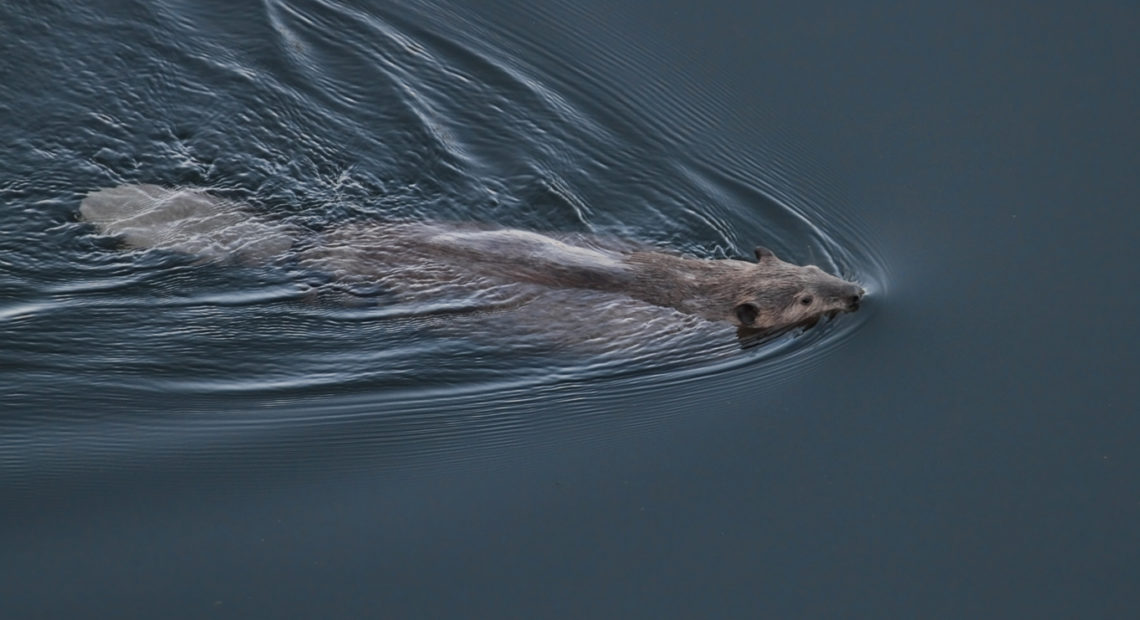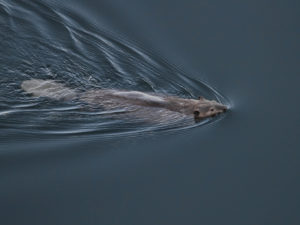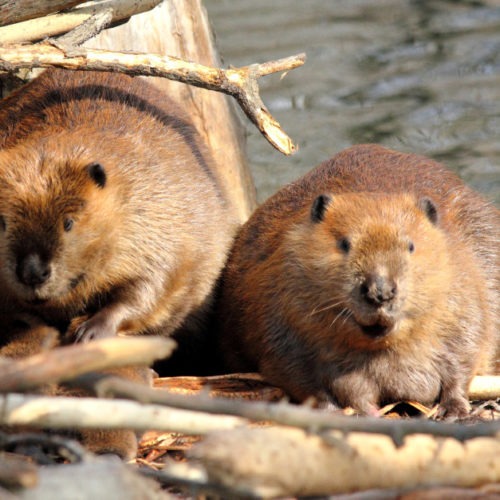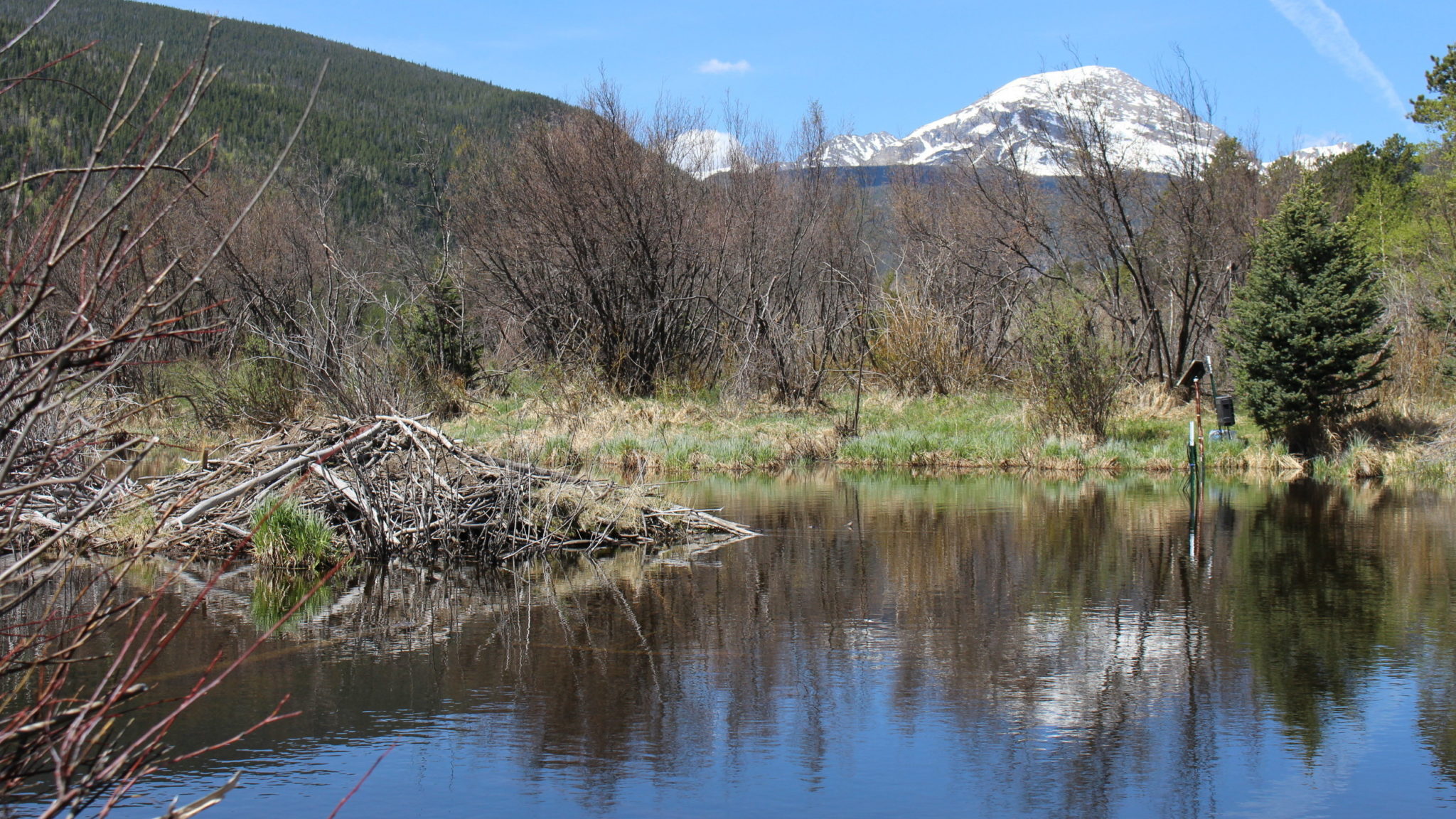
The Bountiful Benefits Of Bringing Back The Beaver
Listen
BY LUKE RUNYON, KUNC
NOTE: The audio version of this story aired June 24, 2018 on Weekend Edition Sunday.
Few species manipulate their surroundings enough to make big ecological changes. Humans are one. Beavers are another.
At one point, the rodents numbered in the hundreds of millions in North America, changing the ecological workings of countless streams and rivers. As settlers moved West, they hunted and trapped them to near extinction. Now there are new efforts across the Western U.S. to understand what makes them tick, mimic their engineering skills, boost their numbers, and in turn, get us more comfortable with the way they transform rivers and streams.
Juli Scamardo treks through a beaver meadow in Rocky Mountain National Park in Colorado early one recent morning.
“These are like mazes,” she says. “It’s hard to get through a meadow and know where you’re going.”
Scamardo is a master’s student at Colorado State University, studying how beavers alter landscapes.
The route includes trudging through the type of mud and muck that grabs your boots and throws you off balance.
“You can probably tell they cause a lot of sediment deposition and we’re stepping through all that right now,” she says.
This wetland maze is made of tiny streams, sturdy willows and a cascade of ponds, home to about two dozen bashful beavers.
“There’s a really shy group of beavers that live here,” Scamardo explains.
Despite setting up movement-sensitive cameras and frequently taking measurements, “we haven’t really ever seen them, but we’ve seen a lot of evidence of them. Obviously, they keep rebuilding their dam, so they have to be here.”
Moving through the meadow is like walking on a massive sponge. The ground is squishy, alternating between wet and dry patches.
She wades through a creek just downstream from a beaver dam, one of many in this stretch near the headwaters of North St. Vrain Creek. Without the beavers’ work, their engineering prowess, this diverse wetland wouldn’t be here. The valley bottom instead would slowly transform back into a grassy plain and the stream would return to its banks, cutting deeper into the landscape, Scamardo says. The whole ecosystem would suffer.
“They definitely are engineers,” she says. “They change their environment to suit them and it also happens to suit a lot of other species.”
Beaver Benefits
The North St. Vrain Creek beavers are a tough bunch.
Heavy snow melt runoff from the jagged peaks of the Front Range frequently undoes all their hard work. On the main creek, away from the marshy wetland, Alex Brooks, a Colorado State University watershed science PhD student, points to a beaver dam made of willows, mud and aspen branches. Last year, the creek blew out the dam. And now it’s back.
“They don’t actually live in these,” Brooks says. “They build these to flood the vegetation …They’ll build lodges where they live. The dams they build all over the place not just where they live.”

Beavers are known as “ecosystem engineers,” species that make precise and transformative changes to their lived environment. CREDIT: LARRY SMITH/FLICKR
Much like us, beavers build dams along streams for their own benefit. They make ponds to protect their lodges and flood areas to increase the vegetation they feed on and use for building materials. While their motivations are selfish, in the process they end up helping their woodland friends, like elk, moose, birds, fish and insects.
Scientists have shown we get lots of benefits, too. Beaver dams improve water quality, trap and store carbon — and in the aggregate could be a significant way of storing groundwater in dry climates.
Beaver reintroduction projects are already underway in Nevada, Utah, Wyoming and Washington state. Sections of Rocky Mountain National Park, and vast swathes of the American West, seem primed for a beaver comeback with plenty of available habitat yet to be turned into beaver ponds, Scamardo says, but they’re not showing up.
“So we’re still asking the question of like, ‘What else do you want?'” she says. “Having a beaver psychologist would really be the best for one of these projects but we don’t have any of those.”
How much help humans should offer beavers as they repopulate the West is up for debate.
It’s Been Done Before
Bringing beaver into areas that haven’t seen them in a long time might seem novel, but it’s been done quite a few times already, with bursts of beaver relocation activity recorded in the 1930s, the 1950s, and the 1980s. Not long after World War II the Idaho Department of Fish and Game redistributed beavers throughout the state using a unique approach.
In video released in 2015 men in slacks and tucked in shirts load beavers into holding crates with parachutes attached. The crates were then placed on an airplane and dropped into backcountry locales.
Yes, at one point in American history we dropped beavers from airplanes.
An Unlikely Advocate
The idea that beavers are friends, not foes, who can help with the West’s water problems is popping up in unexpected places.
At an April water symposium in Denver, gubernatorial candidates took the stage to explain their natural resource platforms. Libertarian Scott Helker followed a string of candidates who pledged support for Colorado’s statewide water plan and the made requisite promises of finding a balance between new reservoirs and conservation.
“I’m so glad to have four minutes instead of a minute,” Helker started. “Because the first thing I’m going to tell you about is: I support beavers. If you only got a minute you sound really crazy.”
At a handful of forums throughout the state, Helker has been using his platform to tout the benefits of beavers. In fact, beaver reintroduction is one of the main planks of his campaign, alongside a pension plan and police reform.
“It’s my belief that if we reintroduce the beavers, it’s one part of many solutions, but it’s a cheap solution, it’s easy to do,” he says. “And it’ll fill up the aquifers and that’s what we want to accomplish I think.”
Helker’s ideas elicited giggles and scoffs from the room of water wonks at the Denver forum, a common reaction to his less conventional talking point, he says.
His beaver plan includes removal of onerous water regulations that create barriers to beaver reintroduction. Plus, he says he would instruct state wildlife officials and encourage local open space departments to prioritize beaver programs.
Does that mean he’s the candidate not just for the people of Colorado, but the beavers as well?
“Yes. I have to,” Helker says. “You’ve got to go that way. I think it’s beaver and people. People and beaver. However you want to put it.”
How To Live In Harmony
Ellen Wohl isn’t laughing at Helker’s beaver fandom.
The Colorado State University geosciences professor has published a few studies on beaver dams and says targeted, intentional beaver restoration projects can bring back stream ecosystems that humans have ruined. She says there are ways to mimic beaver dams to improve water quality and potentially keep seasonal streams flowing year-round, boosting so-called base flows.
“It’s impossible to go back to historical levels,” Wohl says. “But we can certainly actively restore either habitat or reintroduce animals in parts of river networks where it’s feasible.”
Wohl is in favor of using beaver dam analogs — faux dams built by people, meant to mimic how a real dam works — to accomplish some of this work.
“There are lots of places where we can’t reintroduce beaver because there’s just too much urbanization and the river corridor is too constrained,” she says.
But to truly see the benefits beavers can bring, Wohl says we’ll need to rethink our concepts about the animals themselves. State laws across the West classify beavers as a nuisance, a creature that causes problems like flooded basements, dammed culverts and gnawed up trees. Trapping them isn’t regulated like other game species. If a beaver is up to no good on your property you can kill it, no questions asked.
“There are a lot of ways to live with beaver, but you have to be willing to think about those or to think about other alternatives rather than killing the animals,” Wohl says, noting the proliferation of pond levelers that allow property owners to lessen flooding without killing the beavers that cause it.
And it’s not just our ideas about the animals themselves that are problematic, says author Ben Goldfarb. Before writing his new book, Eager: The Surprising, Secret Life of Beavers and Why They Matter, he didn’t realize the profound effects beavers have on waterways. Goldfarb spends much of his time in western waterways casting his fly fishing rod.
“My conception of what a stream should look like was basically wrong,” Goldfarb says.
When beavers were in abundance, before settlers showed up and trapped them for the booming fur trade of the early 1800s, western streams would’ve been a mess, in a good way. Beaver dams, ponds and wetlands would have occupied the channels we know as the clutter-free rivers and creeks of today.
“These sorts of beaver-influenced watersheds are actually in many cases more natural than the classic, shallow, clear riffle stream that people like me like to fish,” Goldfarb says.
Meaning, to truly live harmoniously with beavers our very idea of what a river should look like will need to change.
This story is part of a project covering the Colorado River, produced by KUNC and supported through a Walton Family Foundation grant. KUNC is solely responsible for its editorial content.
9(MDAyOTk4OTc0MDEyNzcxNDIzMTZjM2E3Zg004))
Related Stories:

Federal Agency Will Stop Killing Beaver State’s Beavers To Help Salmon
It took the threat of a lawsuit, but a federal agency is no longer killing the Beaver State’s beavers. Environmental groups had challenged the practice in Oregon because, they said, it’s a threat to more than just the state animal. Like much in the Northwest, it touches on salmon.
















